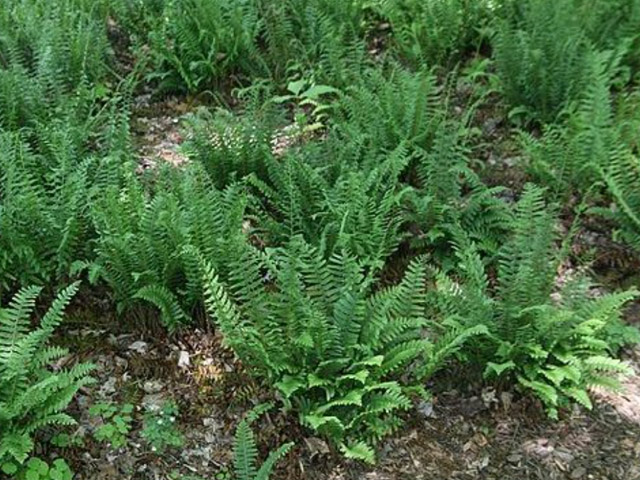Native Pollinator Grasses, Ferns and Sedges
Recommended Grasses, Ferns and Sedges
Grasses and sedges provide great materials for nest building and food/cover in winter.
Ferns date back more than 300 million years and are one of the oldest living plant groups, pre-dating wildflowers.
Below is a list of suggested grasses, ferns and sedges native to North Carolina. Most of the plants listed can be found in all three major regions of North Carolina (Piedmont, coastal, mountain). This list isn’t intended to be comprehensive and only highlights a selection of native grasses, ferns and sedges that nurseries and garden centers are most likely to carry.
North Carolina Native Grasses, Ferns and Sedges
Christmas Fern
Christmas fern, Polystichum acrostichoides, is an evergreen fern native to the eastern half of North America. It occurs naturally in woodlands, swamps, streambanks and other riparian habitats, and can be grown in all three regions of North Carolina.
The Christmas fern is an erect, clumping fern that can reach one to three feet tall. Its fronds arch slightly near the top giving it a fountain-like appearance. These ferns prefer to be planted in partial to full shade. They will adapt to moist or dry soils, however, they do not perform well in soils with poor drainage.
Similar to other ferns, Christmas ferns do not produce flowers or fruits. Instead, they reproduce with the spores that develop on the back of narrow and green fertile fronds. The plant also has sterile fronds that are evergreen and wider, gradually tapering to a point.
These ferns provide excellent habitat for wildlife by adding understory cover to the landscape - perfect for small birds, mammals and other critters. Birds sometimes use parts of the plant as building material for their nests.
Christmas ferns can be planted on slopes to help control erosion or as an understory plant in a shade garden, woodland garden, or natural area.
Fun Fact: The name "Christmas fern" hails to the frond leaflets that resemble Christmas stockings and its evergreen leaves that stand out at Christmastime.
Pink Muhly Grass
Pink muhly grass, Muhlenbergia capillaris, is a native, warm-season perennial that is naturally found growing in sandy pine openings and prairies in the eastern half of North America.
Pink muhly grass prefers dry to medium soils and is tolerant of drought, making it an excellent addition to sandy or rocky gardens, which tend to have fast drainage. Plant it in full sun or partial shade for best display. This clumping grass can reach a height of 1-3 feet tall making it a great selection for borders or mass plantings in a garden.
Pink muhly grass is best known for its striking blooms, which appear as pink, feathery plumes in late fall. These large inflorescences hover over the slender, dark-green blades of the grass beautifully.
Since pink muhly grass is wind-pollinated, its pollen doesn't attract too many pollinators, but it still greatly serves wildlife. Songbirds and small mammals may eat the seeds, but the plant is typically untouched by deer. This grass also creates excellent cover and nesting materials for wildlife.
It can be incorporated into a variety of gardens including cottage gardens, meadow gardens, rain gardens, and more. Pink muhly grass makes a truly stunning display when planted en masse.
Fun Fact: Pink muhly grass is tolerant of air pollution, making it an ideal choice for roadside or city gardens.
Switchgrass
Switchgrass, Panicum virgatum, is a native perennial grass that is indigenous to most of North America. Switchgrass can be naturally found growing in prairies, meadows, and open woodlands. It is a warm-season grass, meaning that it is actively growing during the warmer months.
Switchgrass is a versatile plant that can grow in both full sun or partial shade and in a variety of soil types, ranging from clay to sandy soils. It is tolerant of both dry and moist soils and will survive periods of drought or flooding. Switchgrass can also withstand erosion and air pollution, making it an excellent choice for slopes, ditches or roadside gardens.
The erect and slender blades of switchgrass form a 3-4 foot high columnar shape, adding an interesting texture to garden beds. Switchgrass typically forms a dense clump, slowly spreading through rhizomes, which provides great cover and nesting material for wildlife. Bees may incorporate the grass into their nests, while the larvae of skippers and satyrs munch on the leaves.
Blooms begin appearing in early fall and form loose panicles of green or brown flowers. Switchgrass is wind-pollinated, so the flower stalks typically appear above the blades of grass. Once ripened, the seeds display a beautiful reddish-purple or brown color that will persist into the winter. The seeds are foraged in the fall and winter by terrestrial birds and other wildlife.
Switchgrass can be incorporated int0 meadow or prairie gardens, borders, rain gardens, or naturalized areas. The plant becomes dormant in late fall but will retain its shape through winter. Make sure to cut old growth back in late winter or early spring to make room for new growth.
Fun Fact: Switchgrass is commonly used to make hay.
Order Your Butterfly Highway Sign
Put up a Butterfly Highway sign to show off your amazing pollinator pitstop and start the conversation in your community about helping pollinators and conserving wildlife habitat.
Get Your Native Seed Packets
One packet of native seeds provides as many as 7 different kinds of native flowering plants for monarchs and other pollinators, creating up to 25 square feet of habitat. The seed variety includes purple coneflowers, milkweed, black-eyed Susans, and more!







